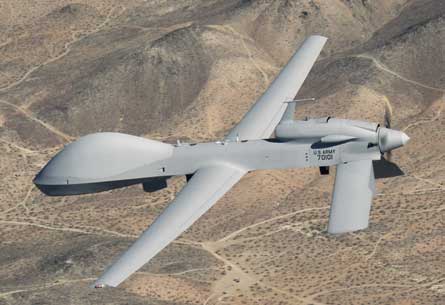The US Army has adopted a new acquisition strategy for fielding a fleet of General Atomics MQ-1C Sky Warrior unmanned aircraft systems, with Department of Defense undersecretary John Young having recently approved a plan to deploy an interim system on time, rather than extend the programme to wait for a delayed payload.
The army's first Block 1 MQ-1Cs will be equipped with Raytheon's multi-spectral targeting system, which provides full motion video from medium altitude. It had also planned initially to field the first Block 1 aircraft with a synthetic aperture radar, but the timetable for the payload was disrupted when technical glitches forced it to cancel an order for General Atomics' Lynx II.
Instead, the army selected Northrop Grumman to deliver the Starlight SAR pod as a replacement, but that remains in the prototype stage, says Tim Owings, the service's deputy UAS programme manager.
 |
|---|
© US Army |
"We will not delay any procurements for the Warrior programme to wait on that," Owings told the Association for Unmanned Vehicle Systems International's Unmanned Systems Programme Review in Washington DC earlier this month. "The capability is too important to the fight for us to wait around for a payload development when we can deliver full motion video, lesser SAR capability and other things that can be delivered today."
Urgent operational demands have forced the army to field six different versions of the Sky Warrior, starting with the I-Gnat, Warrior A and Warrior Block 0 types already deployed in Afghanistan and Iraq. And the army's insatiable need for real-time, airborne video feeds could greatly expand the programme.
"[Sky] Warrior is starting out at 10 divisions with one additional [unit] at the school house. But we show numbers as high as 35-40 potentially for Warrior systems, depending on how we end up fielding those," Owings says.
As more MQ-1Cs are fielded, the type's capabilities will also be dramatically expanded. The army has launched studies for an "enhanced" version capable of greater range and the ability to carry heavier payloads beneath its fuselage.
The UAS system is now being optimised for a surveillance and reconnaissance role, but is also expected to carry new sensors, such as a tactical signals intelligence payload being developed for integration with the MQ-1C after 2011, Owings says.
Meanwhile, the US Air Force plans to integrate the Sierra Nevada "Gorgon Stare" wide area persistent surveillance payload on its General Atomics MQ-9 Reapers, but envisages the sensor as being useful for the army's MQ-1C and AAI RQ-7 Shadow fleets.
However, Owings says the army would instead prefer to develop a wide area sensor that is optimised for a small platform, such as the Shadow. "We're not ever going to be like the air force or the CIA," he says. "We're looking at a depth of infrastructure that frankly the other services don't have to deal with in terms of quantity and number of units and all the different missions we're trying to support."
Source: Flight International























